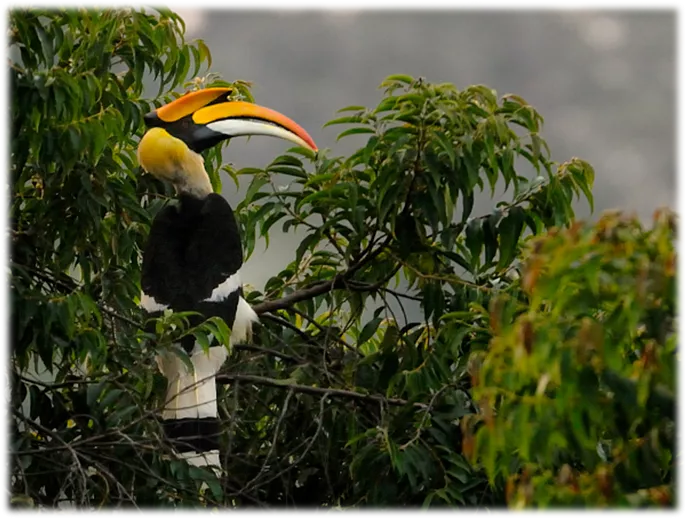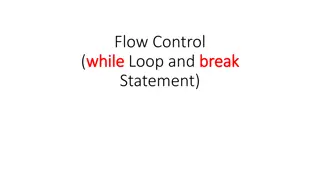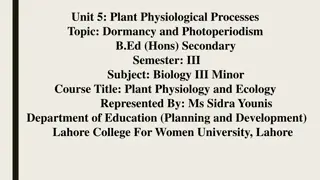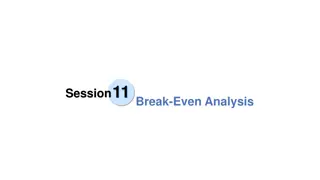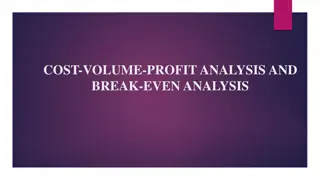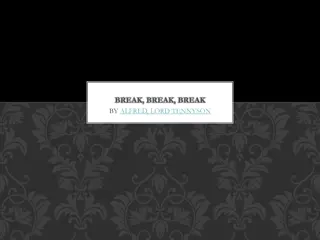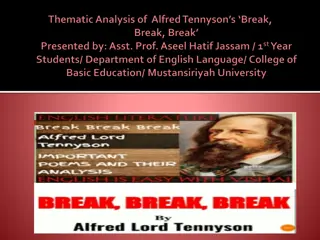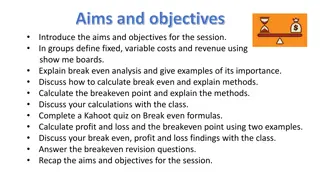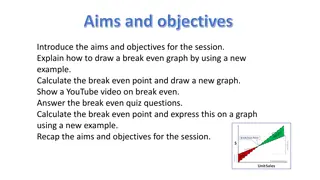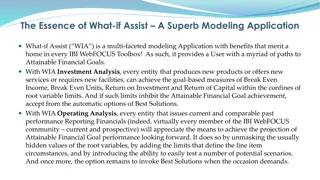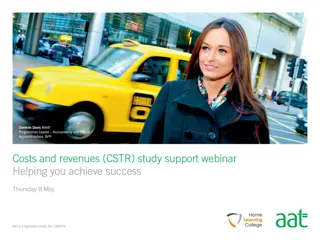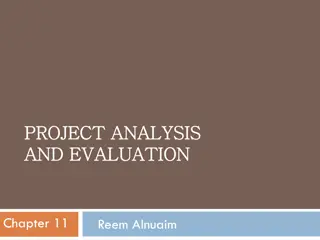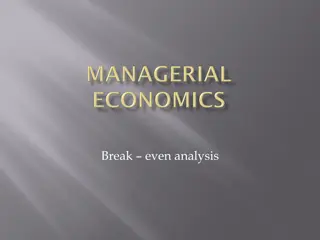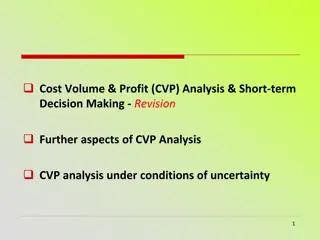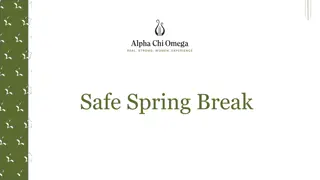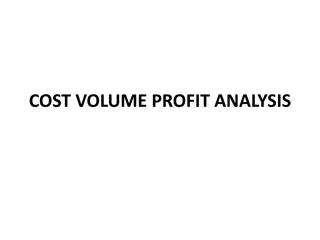Understanding Break-Even Analysis in Business
Break-even analysis is a valuable tool that helps businesses determine the point where total revenue equals total costs, leading to neither profit nor loss. This analysis explores fixed costs, variable costs, and their impact on profitability, offering insights into pricing strategies and decision-making processes. By understanding the concept and application of break-even analysis, businesses can make informed decisions to achieve desired levels of profit. Join us for an insightful seminar presenting case studies and discussions on this fundamental business concept.
Download Presentation

Please find below an Image/Link to download the presentation.
The content on the website is provided AS IS for your information and personal use only. It may not be sold, licensed, or shared on other websites without obtaining consent from the author. Download presentation by click this link. If you encounter any issues during the download, it is possible that the publisher has removed the file from their server.
E N D
Presentation Transcript
WELCOME WELCOME 1
IV - SEMINAR ON Application of Break-Even Analysis A review PRESENTATION BY : ABDUL SATTAR FAZELY PALB 2309 Sr. Ph.D.(Agril. Extn.)
CONTENT OF THE SEMINAR Introduction Objectives Concept and definition Theory of production Application of Break-even analysis Case Studies Conclusion
INTRODUCTION Break even analysis is a useful tool to study the relationship between fixed costs, variable costs and returns. A break- even point defines the value of output or benefit generated, will be equal to the total cost incurred. This is the no profit no loss point and if at all any profit is expected, the level or value of the output should increase above break-even point. This technique can be used to arrive at the level of production or benefit to generate for reaching the derived level of profit. 4 09-09-2024
OBJECTIVES OF THE SEMINAR 1. To understand the concept and definition of Break even analysis 2. To know and discuss about the application of Break even analysis 3. To review the case studies related to Break even analysis. 5 09-09-2024
Concept and definition Break even analysis is used to determine how much sales volume your business need to start making a profit. Thus, Break even analysis is specially useful when you are developing a pricing strategy, either as part of a marketing plan or business plan. 6 09-09-2024
Cont.. Break even point analysis is a decision-making aid that enable a manager to determine whether a particular volume of sales will result in losses or profits. In economic and business, specifically cost accounting, the break even point (BEP) is the point at which cost or expenses and revenue are equal ; there is no net loss or gain, and one has brokeneven (Total cost=Total revenue= BEP) 09-09-2024 7
Basic concept Fixed cost : are those costs, which are incurred after the decision to enter into a business activity is made. These are expenses that do not vary or change according to production. Whether there is production or no production, this cost will have to be incurred as long as the unit is functioning. The fixed cost includes depreciation on equipment and building, interest costs and taxes. Variable cost : are those cost which vary in the same proportion with variation in output. This includes expenses directly related to the production of an output or commodity. 09-09-2024 8
Cont Revenue is the total income received. Profit is the money you have after subtracting fixed cost and variable cost from revenue. Expected unit sales is the number of units of the product projected to be sold over a specific period of time. Unit price is the amount of money changed to the customer for each unit of a product or service. 09-09-2024 9
Cont.. Total variable cost is the product of Expected Unit Sales and Variable Unit Cost (TVC = EUS * VUC) Total cost is the sum of fixed cost and total variable cost for any given level of production. ( Total Cost = Fixed cost + Total variable Cost) Total Revenue is the product of expected unit sales and unit price. (TR = EUS*UP) Profit or loss is the monetary gain (or loss) resulting from revenues after subtracting all associated cost. ( P or L = TR TC) 09-09-2024 10
09-09-2024 11
Theory of production 1- Meaning of production 2- Production function 3- Factors of production 4- Law of variable proportion and law of returns to scale. 09-09-2024 12
Meaning of production Production is a process that creates/adds value or utility. It is the process in which the inputs are converted into outputs. Production refers to the transformation of inputs or resources into outputs of goods and services. Input: The factors of production such as land, labour, capital, technology etc. Output: The goods and service produced such as soap, shoes, car etc. 09-09-2024 13
Production function It means the functional relationship between inputs and outputs in the process of production. It is a technical relation which connect factors inputs used in the production function and the level of outputs. Q = F (Land, labour, capital, technology, organization etc) 09-09-2024 14
Factors of production According to classical economics the factors of production are as follows: Land/Natural resource: such as surface, air, rivers, sea, fauna and flora etc. Labour: Mental or physical effort done by a man. Capital: Man made goods used in the production process. Organization: Entrepreneur or coordinator of all other factors of production. 09-09-2024 15
Law of variable proportion and law of returns to scale. Under law of variable proportion: only one variable input varies all other variables kept constant and it is for short period. Under law of returns to scale: all the variables inputs varies except the enterprise and it is for long period. 09-09-2024 16
Fixed inputs and Variable inputs Fixed inputs Variable inputs Remain the same in the short period and in any level of output In the long run all factors of production are varies according to the volume of outputs The cost of these inputs are called fixed cost The cost of variable input is called variable cost Example: building, land etc. Example: raw materials labour, etc 09-09-2024 17
Various concept of production Total Product (TP): Total physical product is equal to the total amount of output produced in physical units Average Product (AP): Total output divided by total units of input, means production per unit of input ( AP = TP/L) Marginal Product(MP): The extra product or out put added by one extra unit of that input while other inputs are held constant. (MP = TP/ L ) 09-09-2024 18
Types of cost Money cost: The amount spend in terms of money for the production of the commodity is known as money cost. Nominal cost: It is the money cost of production Real cost: It is the mental and physical and sacrifices undergone with a view to producing a commodity. Opportunity cost: The real concept of production of given commodity is the next best alternative sacrificed in order to obtain that commodity 09-09-2024 19
Cont.. Implicit cost: It is the cost of self-owned resources such as salary of proprietor. Explicit cost : It is the paid- out cost. Accounting or business cost: Cash payments which firms make for factor and non-factor input depreciation other book keeping entries Social cost: It is the amount of cost the society bears due to industrialization. 09-09-2024 20
Cont.. Entrepreneurs cost: It is the cost of production in the sense of money cost or expenses of production. Economic cost: It is the cost related to the future, it is in the nature of the incremental cost Direct cost: It is the cost that have direct relationship with a unit of operation like a product- process or a department of the firm. Ex; Variable cost. 09-09-2024 21
Cont.. Indirect costs: Are those whose source cannot be easily and definitely traced to a plan, a product, a process or a department. Ex: fixed cost. Controllable costs: Are those which are capable of being controlled and can be used for assessing executive efficiency. Non controllable costs: Are those which cannot be subjected to administrative control and supervision 09-09-2024 22
Types of Average cost Average Fixed Cost: It is the per-unit cost of the fixed factor (AFC=TFC/Q) Average Variable Cost: It is the per unit cost of the variable factors (AVC=TVC/Q) Average Total Cost: It is the total cost divided by the number of units produced (ATC=TC/Q) Marginal Cost: Change in the total cost resulting from the unit change in the quantity produced (MC=change in Q/change in TC) 09-09-2024 23
Application of Break-Even analysis 09-09-2024 24
Uses of Break-Even analysis Break-even output price can be used as a sample risk management tool to evaluate the impacts of marketing decisions under the price variability. Break-even yield analysis can be used to find the maximum potential yield losses due to detrimental weather condition 09-09-2024 25
Cont Break-even input price can be used to determine the price prevailing in the market. Input requirement break-even analysis can be used to study the economic impact of input requirement during unfavorable season to avoid yield losses. 09-09-2024 26
Sample Problem (1) Assume you own a business selling burgers. It costs Rs. 7.00 to make one burger. That s your V or Variable cost. You sell each burger for Rs. 12.50 That s your P or price per unit. Your cost for rent utilities, overhead, etc. is Rs. 100,000 per month. That s your F or Fixed cost. 09-09-2024 27
Cont Answer Given: V = Rs 7.00 P = Rs 12.50 F = Rs 100,000 Solution: X= F/(P - V) X= 100,000/(12.50 7) X= 100,000/(5.5) X= 18,181.818 = 18,182 To break-even you would need to sell 18,182 burgers 09-09-2024 28
Sample Problem (2) Assume you own a lemonade stand. It costs you Rs. 1.50 to make cup of lemonade. You sell your lemonade for Rs. 5.00. It costs you Rs. 5,000 to rent for the space of your lemonade stand. How many cups of lemonade do you have to sell to breakeven? 09-09-2024 29
Cont Given: V = Rs 1.50 P = Rs 5.00 F = Rs 5,000 Solution: X= F/(P - V) X= 5,000/(5 1.50) X= 5,000/(3.5) X= 1,428.57 1,429 You would need to sell 1,429 cups of lemonade to breakeven 09-09-2024 30
Margin of safety: Margin of safety defined as the percentage of excess production over break-even point to the actual production. It indicates to what extend the production may decline before the firm starts incurring losses. In the break- even point, the distant between break-even point and the point of actual production indicates the margin of safety. 09-09-2024 31
Cont.. Margin of Safety = Actual output-BEP/ Actual output 100 Higher margin of safety indicates the financially soundness of the company. 09-09-2024 32
09-09-2024 33
Advantages of break-even analysis The main advantages of break-even analysis are: It explains the relationships between cost and output level. The technique is useful to determine changes in the profit level whenever there is change in fixed cost, variable cost, and prices of commodity. It indicates the lowest amount of business activity to prevent losses. This technique is also used to determine the viability of project at the particular point of time. 09-09-2024 34
Uses of Break Even Point Helpful in deciding the minimum quantity of sales. Helpful in the determination of tender price Helpful organization s profitability. in examining effects upon Helpful in sales price and quantity Helpful in determining marginal cost. 09-09-2024 35
Limitation It is best suited to analysis of one product at a time. There should be no change in the investment of fixed assets. Variable cost should remains constant per unit. Productivity of workers remains constant, i.e. method of production and efficiently of men and machine remain unchanged. 09-09-2024 36
REVIEW OF CASE STUDIES 09-09-2024 37
I. PROJECT APPRAISAL BY BREAK-EVEN ANALYSIS: CASE STUDY OF A DAIRY PROJECT C. Kannpiran (1987) 09-09-2024 38
In this study the practical utility of the break- even analysis with reference to dairy project is discussed. The details of the cattle are: Cross-bred cows were purchased immediately after calving in 2 stages of 5 animal each at an interval of 6 months. 09-09-2024 39
Cont The average milk yield is 10 liters/day/animal and sale price is Rs. 4/liters of milk. Average day-in milk 10 months and dry-day 5 months Feeding cost per animal details is presented in the table below 09-09-2024 40
Table: 1 Details of feeding cost per animal Sl. No . Production ration for milking animal Maintenance of all animals Details 1 Concentrate feed for maintaining at 1 Kg/ animal 2.5 For milking animal at 1 Kg for every 2.5 liters of milk yield (4) Green fodder 25 Kgs 0.10 10.0 2 2.5 3 Dry fodder 5 Kgs 0.20 1.0 Total 6.0 10.0 09-09-2024 41
Cont.. The dairy project should carefully analyze the cost considered. These cost include capital cost and operating cost. A. Capital cost (Investment cost): Capital costs are those cost incurred for creation of goods that are capable of producing economic wealth is termed as capital assets. In case of dairy projects, the investment made on building (cattle shed), equipments and animals are considered. 09-09-2024 42
Table: 2 Investment cost in dairy projects Sl. No. Particulars Cost (Rs) Cost of 5+5 dairy animals at Rs. 6000 each 60,000 1 Cost of construction of cattle shed, i.e. 700 sq. ft at Rs. 50 per sq. ft 35,000 2 Cost of equipments (buckets, milking vessel, ect.) 5,000 3 Total capital cost 1,00,000 09-09-2024 43
B. Operating cost : Fixed cost: such as permanent labour wages, land taxes, electricity bills, maintenance ration and depreciation Variable cost: Are those cost, in which milking animal ration and special veterinary care are considered. The milch or milk ratio is 1 Kg of concentrate feed for every 2.5 liters of milk yield and this varies according to the production of milk. 09-09-2024 44
Table:3 Annual Operating cost in dairy projects Sl. No. Particular Cost (Rs.) A Fixed Cost 1 Maintenance cost of ration for all animals (10 365 6) 21,900 2 Labour charges (permanent labourers) 6,000 3 Taxes, electricity, etc. 1,200 4 Veterinary care (average Rs. 50/animal/year 500 5 Depreciation a) On animal 15% 9,000 b) On equipment 10% 500 c) On sheds 2% 1,200 Total Fixed cost 40,300 B Variable cost 1 Cost per liter 1 09-09-2024 45
Table: 4 Milk flow chart 2nd batch animal (5) Total milk producti on (liters) 1st batch animal (5) Total days Years Milk days Dry days Milk days Dry days Milk Dry I 1500 300 900 900 2400 1200 24000 II 1350 450 1050 750 2400 1200 24000 III 1050 750 1050 750 2100 1500 21000 IV 1050 750 1500 300 2550 1050 25500 V 1050 750 1350 450 2400 1200 24000 VI 1500 300 1050 750 2550 1050 25500 09-09-2024 VII 1350 450 1050 750 2400 1200 24000 46
Break-even analysis: Break-even level for production = FC/(Sale price/unit variable cost/unit)= 40,300/(4-1)= 13,433 liters/year Break-even level for sales = FC Sale price/unit /(Sale price/unit variable cost/unit)= 40,300 4/(4-1)= Rs. 53,732/yp Margin of safety = Actual output BEP/AO 100 = 21000-13433/21000 100 = 56.33% 09-09-2024 47
Findings >Break-even point at a milk production level of 13,433 litters per year, Break-even level of Rs. 53,732/year s production for sales and the percentage of 56.33% on Margin of safety > Indicates that dairy project is a viable and profitable project 48 09-09-2024
II. Application of Break-even analysis in Vanilla cultivation as intercrop in areca garden Carl R. Dillon(1993) 09-09-2024 49
Cost element The cost element used in break-even analysis is classified into : A. Establishment cost B. Cost of cultivation and Return of vanilla A. Establishment cost: These cost incurred for establishing vanilla in areca garden. These costs are non-recurring costs. The establishment cost include fixed cost and variable cost 09-09-2024 50


